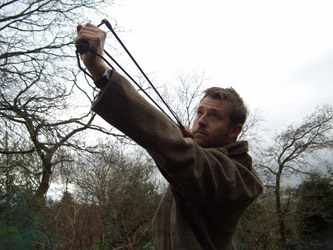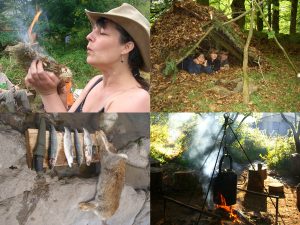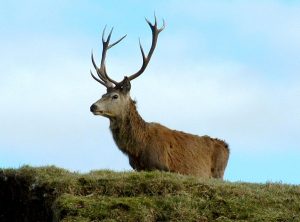In the minds of many people a catapult is nothing more than a child’s toy, or one of the weapons used by the “Beano’s” Dennis the Menace to terrorise the softies (for those of us old enough to remember). Few people these days would ever consider using a catapult for hunting, but not too many years ago catapults were the tool of choice for poachers and anyone else who wanted to “discreetly” hunt small game animals and birds for food.
While staying with The Orang Asli people of the Cameron Highlands in Malaysia, I watched youngsters using catapults to hunt birds, lizards and small mammals. The catapult was considered a good learning tool for novice hunters to hone their stalking skills and accuracy, before they could be trusted to use a blow pipe, or more commonly these days, a shotgun.

A forked stick becomes a whittled catapult
Provided that all game regulations are complied with, and you have permission to shoot over land, then hunting with a catapult is still a valid hunting method for the modern day bushcrafter, or for anyone surviving in the wild. The real beauty of the catapult is its compact size which allows it to be tucked away in a pocket, belt, or up ones sleeve until it’s required. This makes it an ideal choice for “opportunist” hunting, while going about your other business like setting traps and foraging.
I wrote about Hunting with an air rifle, and many of aspects of Air Rifle Hunting could equally be applied to hunting with a catapult. These include the ability to stalk and walk quietly, camouflage and concealment and tracking. However, unlike an air rifle the technique for shooting a catapult is more spontaneous, requiring many hours of practice to become proficient enough to hunt effectively and humanely, in this respect it has more in common with archery.
The effective range of a catapult is fairly limited, so for practical purposes they should really only be used for hunting ranges of around 15-20 metres maximum. Despite their short range a good catapult with the correct ammunition packs a lot of punch, and in terms of energy delivered to the target this can be several times more power than the legal 12Ft Lbs legal limit for air rifles in the UK. This devastating power makes a catapult a humane weapon for small game.

How to use a catapult, the wrist brace helps with accuracy
The catapult I have owned for many years is an extremely powerful manufactured model with a wrist brace. This wrist brace really helps to maintain accuracy and reduce strain on the arm. My preferred choice of hunting ammunition is .38 calibre steel ball bearings or lead shot. I’ve successfully used this catapult to hunt rabbits and squirrels for food on many occasions, and often take it with me on walks for impromptu roving, or target practice.
I have found that I achieve the best results when I don’t try too hard to aim before releasing the projectile. Through constant practice you will develop the necessary muscle memory and instinctive aim for taking fast shots as they present themselves. The catapult is held and used in a similar way to an archery bow. The projectile in its leather pouch is held between the folded index finger and thumb of my right hand. (I am right handed so if you’re left handed just reverse this description). As the left hand holding the catapult is raised and the arm straightened, the right arm is simultaneously drawn back, using the shoulder and back muscles, with the elbow held high. The pouch is drawn back to the same position at each shot, and I use the side of my thumb against my cheek bone as a guide. To take a shot the pouch is released and the projectile is propelled forward (hopefully) between the arms of the catapult and towards the target.
Occasionally when practicing you will hit your hand when it shoots forward, this hurts, but serves as a good reminder to hold the catapult straight next time.
Catapults were traditionally made using a forked stick and a piece of elastic material which would provide the spring to propel a pebble or other projectile. In a survival situation you may be able to improvise using surgical tubing, bungee cord, Latex gloves, and pieces of tire inner tube, elastic bands, or anything else that will provide enough spring. You can buy very effective tubular or square section latex rubber in many fishing and shooting shops, and a metre length should be plenty for one good catapult.

Successful hunting for dinner with a manufactured catapult
In order to make a catapult you will also need a piece of stiff leather (Cut from an old boot is fine) and some whipping twine, strong thread, fishing line or dental floss to hold it all together. The best place to find a good forked stick for a catapult is in hedgerows where the trees have been cut back and started to re-grow. You are looking for a forked (Y shaped) stick with the V arms of the catapult of equal diameter. The handle should be thick enough to provide a good grip. The best woods for catapults are Hawthorn, Blackthorn, Hazel, Holly, Ash or any other strong hardwood. It is also best to allow the wood to season for a few months if you’re not in a hurry to use your catapult, but in a survival situation green wood will work fine.
Cut the catapult to a convenient size and shave off the outer bark using a knife. At this stage you can also remove any rough areas and shape the handle for comfort.
Carefully carve the ends of the arms as illustrated. These notches will allow the elastic to be firmly attached.
Cut the leather strip approximately 2” x 5” and fold each end over 1.5”. Using an awl or tip of a knife cut a circular hole through the folded section of leather on each side; this folded section increases the strength of the leather when the elastic is threaded through.

To make your own catapult, securely attach the elastic to your forked stick
Push the end of the elastic through both holes allowing around a 1” tail to protrude. Fold this back parallel with the main section of elastic, and very tightly wrap both sections together using strong cord (See illustration). Repeat on the other side.
You should now have a leather pouch with equal length elastic at each end.
Making sure that the elastic isn’t twisted fold one end over the top of the catapult arm and tightly lash it down using the notches to hold it securely, repeat at the other side.
You should now have a completed catapult. Use small stones, marbles, ball bearings, or lead balls as projectiles, and practice until you are confident of hitting a tin can at 10 metres every time.
Obviously, common sense is required whenever you use a catapult, and serious injuries can occur if they are misused. Always ensure that you have a safe backstop to catch the projectiles, and always treat a catapult in the same way as you would treat a gun…. Never point it at anyone.
While reading about Survival Skills is a great way to build knowledge nothing beats learning from the experience of a professional Bushcraft Instructor….

Andrew Price spends every spare moment in the pursuit of Adventure. He has travelled extensively all over the world in order to study the traditional skills of indigenous peoples including the Orang Astli people of the Cameron Highlands in Malaysia, as well as the native inhabitants of Australia and Canada. Andrew runs Dryad Bushcraft, one of the UK’s leading Bushcraft and Survival schools.




3 Comments
What a horrible, cruel and disgusting murderous article.
Hi
Horrible & disgusting are subjective.
Cruel? Death is instant. Billions of animals are killed in nature every day, and I can’t think of a way that would be less cruel than this.
Murderous? If you’re saying that ‘meat is murder’, then it follows that your position must be either that:
a) we should intervene in nature to stop predators murdering prey animals, or
b) humans are not part of nature.
Philosophically, both those options present extreme difficulties. Option a) is impossible, and any attempt to do so would be very damaging for ecosystems, and b) throws up a lot more philosophical problems than meat-eating, and is patently untrue – humans are completely dependent on nature for all the things that keep us alive – fresh air and water, soil fertility, pollination etc., as well as being an integral part of it by way of our DNA and evolutionary history.
Your position may be that only humans have the mental faculties to be capable of ‘murder’, but that’s not really any consolation to the animals that are killed. To label something murder is to be against the killing, surely. But if you’re content that animals are killed in nature, then it can’t possibly be about the killing – only the effect that it has on the killer (and only if the killer is a human).
This is for food. We are a sustainability organisation, and harvesting meat, fish, plants and fungi from the wild is just about the most sustainable way to get food. No natural habitat needs to be removed for agriculture.
Would you ban this practice? Would you ban it among the Orang Asli people mentioned in the article?
Indie, why are you here – on this website? As Dave has so clearly stated, your comments are subjective, and, if I may say, offensive to me, if not many others. So does that make me a ‘ bad’ person?